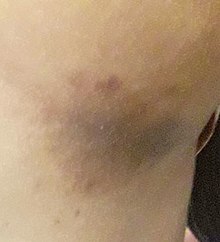| Erythrasma | |
|---|---|
 | |
| Specialty | Dermatology |
| Causes | Corynebacterium minutissimum |
Erythrasma is a superficial skin infection that causes brown, scaly skin patches. It is caused by Corynebacterium minutissimum bacteria, a normal part of skin flora (the microorganisms that are normally present on the skin).
There are two types of erythrasma: generalized and interdigital. Interdigital is the most common bacterial infection of the feet and normally does not show any symptoms. Not only is this an aesthetically unappealing condition, but there is evidence to support that disciform erythrasma can be an early sign of type 2 diabetes mellitus. The generalized erythrasma is most commonly seen in type 2 diabetes mellitus where the lesions go beyond the areas of the body where skin is rubbing together.[1] It is prevalent among diabetics and the obese, and in warm climates; it is worsened by wearing occlusive clothing.
The presence of erythrasma is approximately 4% and is more likely to be found in the subtropical and tropical areas compared to the rest of the world. It is found more commonly in African Americans due to the darker skin and even though both sexes are affected, it is usually found more frequently in males for the thigh and leg regions.[2] A great contributor to this infection is a weakened immune system which comes with aging, therefore the elderly are more susceptible to this disease than the young; this does not mean the young cannot be affected. The epidemiology background of erythrasma remains partially unsolved.
- ^ "Erythrasma - American Osteopathic College of Dermatology (AOCD)". www.aocd.org. Retrieved 2017-11-06.
- ^ "Erythrasma". misc.medscape.com. Retrieved 2017-11-06.